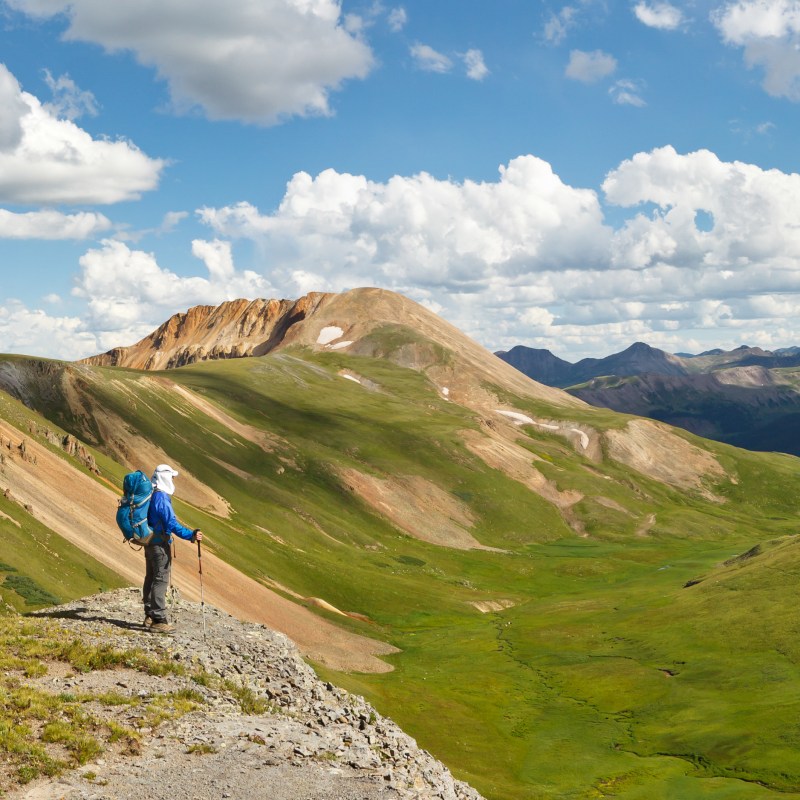
Colorado is popular, with 85 million tourists descending on the state every year. Fortunately, there’s plenty of public room to spread out. There are 24.5 million acres of public lands as approximately 37 percent of the entire state is preserved as national parks or national forests. These lands include the biggest collection of the highest peaks in the country, many of which you can witness on these stunning Colorado hikes.
Videos by TravelAwaits

1. North Vista Trail, Black Canyon Of The Gunnison National Park
Montrose County
Black Canyon of the Gunnison National Park is only 47 square miles, and much of those are sheer canyon walls. The Black Canyon got that name because some parts of the canyon only get about 33 minutes of sunshine every day since the canyon walls are so steep and narrow.
My suggestion for hiking the Black Canyon is the North Vista Trail, a walk that won’t scare you but will get you to a place called Exclamation Point after about a mile and a half of easy walking. You can keep on going, and after another three and a half rather strenuous miles, you’ll get to Green Mountain. There are a number of switchbacks on the way up Green. The views are spectacular — of the San Juan Mountains and the canyon itself.
To get to the hike, arrive at the north rim from nearby Crawford, Colorado, and start the hike at the North Rim Ranger Station.
If you are looking for the scary hike, there are trails that take you from the canyon rim to the river. One is called the Gunnison Route, and it’s a short, steep route to the river’s edge. Part of the hike includes a long chain to assist in making a really steep section passable.
Pro Tip: Avoid the scary walk to the river!
2. Animas Mountain Trail, San Juan National Forest
Durango
The Animas Mountain Trail starts in the City of Durango in southwest Colorado and is a six-mile loop. You get started on 32nd Street in north Durango, which is one of Colorado’s coolest cities. You can go either direction at the start, but I suggest you go counterclockwise for a less-strenuous walk. Clockwise is a bit easier on the knees on the way down. The views are incredible once you make it through a series of switchbacks.
Pro Tip: This trail is shared by dog walkers and trail runners.
3. Ouray Perimeter Trail, San Juan National Forest
Ouray
A five-mile walk, the Ouray Perimeter Trail is what it suggests. It takes you around the quaint town of Ouray. Ouray, named for a powerful Ute chief, is in southwest Colorado, in the San Juan National Forest. What you get for a relatively quick walk are some great views of Ouray. The entire downtown is on the National Register of Historic Places.
The perimeter hike goes through the cliffs that surround the town and includes bridges, waterfalls, and even a pipeline that you get to climb over. There are numerous spur trails; one takes you through a tunnel and another takes you to a waterfall that in winter is part of the ice climbing park.
Pro Tip: Ouray is noted for its hot springs. Take advantage.

4. Great Sand Dunes National Park
Alamosa And Saguache Counties
This park is located south and west of Pueblo and its surprise factor gets it included here. Sand dunes, in the mountains? It’s an amazing sight: dunes 700 to 750 feet high. There are no trails on the dunes, but you can walk all over them. A word of caution: Hike early morning or in the evening since the sand can reach 150 degrees on a sunny day.
Pro Tip: Be prepared for windy conditions.
5. Colorado Midland Railroad To Hagerman Tunnel
Leadville
Leadville has the distinction of being the highest-elevation city in the United States at 10,152 feet. That’s why I’m not proposing any lung-busting hikes much higher. Here’s a relatively easy, interesting walk along sections of the Colorado Midland railroad bed to the Hagerman Tunnel. It was the highest railroad tunnel in the world at the time it was built in the late 1880s.
If you’re a railroad buff, the trail has lots of interesting railroad remains: trestles, snow sheds, deep rock cuts, and the ruins of a boom town, Douglass City, which was home to the men who built the line. There’s also lots of mountain scenery: meadows and lakes and wide vistas. Do not enter the tunnel, as it is unsafe.
The trail starts on the west side of Hagerman Pass Road, across from the trailhead parking area. It’s clearly marked on area hiking maps.
Pro Tip: Drive the Top of the Rockies Byway, which goes 75 miles from Aspen, through Leadville, to I-70.
6. Sky Pond
Rocky Mountain National Park
This walk is my absolute favorite in RMNP — not too long and a beautiful lake as the payoff. Expect crowds at the beginning, as most visitors are on the trail to get to Alberta Falls, which is about a half-mile from the trailhead. This is a strenuous hike, about nine miles in all, but worth it, especially when you get to climb up a waterfall!
This hike starts at Glacier Gorge Junction. Just follow the signs (and the crowds). As you get deeper into the woods, the crowds thin out quickly. There are a couple of forks in the trail, but they are clearly marked to get you to your destination. Eventually, Timberline Falls is in view, so take a break on some boulders and watch the other hikers climb up. Above the falls, Lake of Glass is in view, and you can see around the lake to Sky Pond. It’s an easy walk even though the lake and pond are surrounded by cliffs that look rather menacing.

7. Chasm Lake
Rocky Mountain National Park
This is my pick for the best hike in Colorado. Check out TravelAwaits’ picks for the best hikes in all 50 states here. RMNP, as aficionados call these nearly 400 square miles just about a 90-minute drive from Denver, has 350 miles of trails. Hikers from expert to novice have plenty of walks to pick, from strolling through meadows to climbing one of Colorado’s “fourteeners,” Long’s Peak. Fourteeners refers to the many Colorado peaks over 14,000 feet. Long’s is not one hike I’ll suggest here, due to its tremendous difficulty for most of us.
Instead, I’ll concentrate on some walks that will give you a taste of what this park is all about, starting with Chasm Lake, an eight-mile out-and-back hike, which is pretty difficult. In fact, part of the trail takes hikers to Longs Peak. The trail to the lake is worth the effort, and you’ll be rewarded with some solitude after leaving the Longs turnoff. This hike is off Highway 7, outside the main part of the park, but you walk into the park proper.
Get started early in the day to avoid afternoon thunderstorms, as you’ll be above tree line for a while. You’ll pass Goblins Camp, which looks otherworldly with its twisted limber pines. Then you’ll climb switchbacks up Mills Moraine to a trail split: Go left for Chasm Lake. The trail to the right heads to Longs Peak.
As the trail descends, watch your step as you look over the edge to Roaring Fork River, fed by the lake. Columbine Falls tumbles out of Chasm Lake, creating a great environment for the Colorado state flower, the blue columbine. The lake is accessed by climbing a ledge, and the route is marked by stone cairns. A perfect spot for lunch.
8. Flattop Mountain
Rocky Mountain National Park
This is a strenuous eight-mile hike, but the trail is smooth and easy on the feet. You start at the Bear Lake trailhead area, but don’t even think about parking there. Take the shuttle bus. You go above tree line, so don’t get stuck at your destination when afternoon storms roll in. The crowds at Bear Lake thin out as you climb switchbacks. Your payoff for the hard work: vistas in every direction, with plenty of room to spread out for lunch.
9. Tundra Hike
Rocky Mountain National Park
Tundra Hike is what my kids call this walk, which goes from the Alpine Visitor Center to Milner Pass, a one-way trip of about eight and a half miles. The good news: It’s all downhill! You need two cars to accomplish this — or be willing to thumb a ride back to your car at the visitor center. The visitor center is on Trail Ridge Road, the park’s main drag. Park at the visitor center, carefully cross the road, and you’ll see the trail. It crosses above tree line. Along the way, you can peer into Forest Canyon, which was created by a glacier ten thousand years ago. Appreciate the viewpoint from an elevation of 11,340 feet. Later, look for some small ponds on the left. Keep an eye out for sheep and elk. As you enter an area near the tree line, there are krummholz, gnarled trees stunted by the challenging growing conditions.
This little hike has it all: above tree line, below tree line, wild animals, a marshy area, and views of the Continental Divide.
Pro Tip: RMNP is almost overwhelmed with visitors. Opt for shoulder season visits if possible.
This article is presented by KEEN Footwear. I’m rocking Targhee III casual brogues and they are incredibly comfy, even at the end of a six-mile, rocky road. The shoes fit well, even with my extra heavy-duty inserts, required because of my plantar fasciitis. My feet didn’t experience a twinge of pain. The shoes aren’t unduly hot and made a rough road less so. Shop KEEN’s Targhees and other hiking shoes here.
